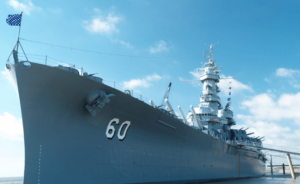About Asbestos in Navy Ships
 Asbestos is a naturally occurring mineral that was used to make thousands of products up until the 1980s.
Asbestos is a naturally occurring mineral that was used to make thousands of products up until the 1980s.
The Navy relied on asbestos materials to build naval vessels due to the mineral’s fire-resistant properties and ability to withstand the corrosive effects of salt water.
Asbestos-containing products could be found from stem to stern on Navy ships.
The dangers of asbestos became public knowledge in the 1970s, and steps were taken to phase out its use. However, by this time, millions of Navy personnel had already been exposed.
Symptoms of asbestos-related diseases can take 10-50 years to appear after an individual’s initial exposure to asbestos.
As a result, many Navy veterans are now being diagnosed with mesothelioma, lung cancer, and other asbestos-related illnesses — decades after they came into contact with asbestos fibers.
LawFirm.com is dedicated to helping veterans with mesothelioma from asbestos on Navy ships fight for the justice they deserve.
Get a free case review right now and see if our team can help you file for benefits with the U.S. Department of Veterans Affairs (VA) and pursue other types of compensation.
What Asbestos Products Were Found on Navy Ships?
Asbestos-containing products were used to build Navy ships up until the 1980s. These products placed sailors and other Navy service members in danger.
Learn about some of the different types of asbestos products used on Navy ships below.
Adhesives
Adhesives and sealants are essential components in military watercraft manufacturing as they enhance stealth, reduce drag, and prevent the growth of marine life on the outside of ships and submarines.
Asbestos-based adhesives were often used along the entire hull of most Navy ships, largely because they are resistant to heat, water, and corrosion.
Boilers
Asbestos was almost always found in Navy ship boilers because of its fireproofing and insulating properties.
Boilers are responsible for creating steam on a ship, and U.S. Navy ships were often large enough to require multiple boilers.
Gaskets
A ship gasket is a type of door seal used to prevent water leakage and is an important component in constructing submarines and other Navy vessels.
In older Navy ships, gaskets were made using a combination of asbestos fibers, rubber, and other materials. The use of asbestos in gaskets allowed them to be flexible and resistant to heat.
Pipes
Every Navy ship contains an extensive network of pipes as a main component of its framework, and these pipes were often insulated with asbestos.
The insulation used consisted of an inner layer of felt and asbestos and an outer layer of tar. In some instances, the inner layer contained up to 50% asbestos.
Pumps
Pumps can be found throughout Navy ships and serve multiple purposes, including supplying water to boilers and seawater to the fire main. These pumps were usually packed with asbestos to keep in heat.
These parts were most dangerous when being worked on or replaced by Navy personnel as asbestos fibers could fly into the air during the process, putting anyone in the area in danger.
Valves
Valves are an important component of Navy ships, as they are found in countless pieces of machinery and control the pressure and distribution of fluids.
Asbestos could be found in the insulation of valves on Navy ships and on the outside surface of these valves, creating a hazard to anyone who worked on these parts.
Other Products
All in all, asbestos could be found in more than 300 parts and products used on Navy ships before the early 1980s.
Asbestos on Navy ships could also be found in:
- Cables
- Caulk
- Cement powder
- Electrical wiring
- Insulation
- Paint
- Tiling
- Many other products
The companies that made and sold these products knew of the health risks associated with asbestos, but they chose not to warn the public in order to protect their profits.
Today, many U.S. Navy veterans with mesothelioma from asbestos on Navy ships have been able to collect VA benefits and get compensation from lawsuits against these negligent companies to help pay for their medical bills and other expenses.
Mesothelioma lawsuits are never filed against the U.S. Navy or government and don’t affect a veteran’s ability to get VA benefits.
Contact our team at (888) 726-9160 and see if we can help you file for VA benefits and pursue legal compensation.
U.S. Navy Asbestos Ship List
Asbestos products could be found on virtually every type of Navy ship — from battleships to submarines — throughout much of the twentieth century.
Use the search tool below to see if a ship you served on contained asbestos.
Type of Ship:
Asbestos Used: Yes
We are unable to locate that specific ship but can find out if it contained asbestos. Contact us below for help.
Get the Help You Deserve
Many U.S. veterans who got sick from asbestos on Navy ships have received over $1 million in compensation.
See If You Qualify for Compensation
A list of the most common types of U.S. Navy ships with asbestos can be found below.
Aircraft Carriers
Aircraft carriers serve as full-length flight decks and airbases, capable of launching and landing military aircraft, transporting aircraft overseas, and acting as mobile seagoing command centers for various types of amphibious military operations.
Unfortunately, asbestos on aircraft carriers placed anyone onboard at risk of exposure, as the toxic material could be found in nearly all components of these vessels. Aircraft carriers often housed around 5,000 sailors and crew members at any given time, putting thousands at risk of serious illnesses.
Auxiliary Ships
Auxiliary ships in the Navy are not main combat ships, but they act as support ships that are important for self-defense.
Asbestos was used in many areas of auxiliary ships, including in wardrooms, boiler rooms, mess halls, and engine rooms.
Battleships
A battleship is a type of large warship that is heavily armed. Asbestos on battleships could be found in insulation and fireproofing, as these ships were frequently attacked and designed to resist fire and heat.
Cruisers
Cruisers, another type of warship designed to be smaller and faster than battleships, contained tons of asbestos products — including panels, tiling, and fire shields – meant to keep those onboard safe during an attack.
However, it’s now known that asbestos on cruisers actually placed these brave service members at risk.
Destroyers
Destroyers are heavily armed naval warships that have multiple offensive and defensive capabilities.
These ships were popular during World War I and World War II, with documentation from the time showing that asbestos on destroyers could be found in deck matting and insulation.
Frigates
Frigates, known for their speed and maneuverability, are often used in scouting and escort missions.
While asbestos could be found in many areas on these ships, the highest concentrations of asbestos on frigates could generally be found in the fire rooms below deck.
Minesweepers
Minesweepers are small warships with the specific purpose of clearing naval mines so other warships can pass through the area safely.
Asbestos was used heavily in minesweepers as thermal insulation, due to their need to withstand heat and fire.
Submarines
Submarines are marine vessels capable of operating underwater or at the water’s surface.
Because these vessels primarily operate underwater, asbestos on submarines posed a real danger to crew members because of poor ventilation and close quarters.
Other Navy Ships With Asbestos
Asbestos on Navy ships wasn’t limited to the vessels listed above. Many other types of ships made up the force that protected America by sea at any given time, and they also contained a slew of asbestos products.
Other types of U.S. Navy ships with asbestos included:
- Amphibious warships
- Clippers
- Corvettes
- Cutters
- Merchant Marine ships
According to the U.S. Department of Veterans Affairs, any Navy veteran who served on vessels with keels laid before 1983 may have been exposed to asbestos. A keel is the backbone of a ship that runs lengthwise along the bottom.
LawFirm.com can help veterans with mesothelioma from asbestos on Navy ships file for VA benefits and pursue other forms of compensation.
Get a free case review and see if we can help you.
High-Risk Navy Jobs on Asbestos Ships
While all Navy jobs placed service members at risk of asbestos exposure, some jobs were more dangerous than others.
Those who worked in high-risk areas of Navy ships — like in the damage control room, engine room, or pump room — were more likely to breathe in or swallow toxic asbestos fibers.
Asbestos fibers were often dispersed into the air when asbestos-containing materials were installed, serviced, or maintained. Even normal vibrations from a ship at sea could disturb these microscopic particles and cause them to become airborne.
High-risk Navy jobs included:
- Boiler technicians
- Fire control technicians
- Machinist’s mates
- Pipefitters
- Shipbuilders and shipyard workers
Many other naval jobs also caused workers to be exposed to asbestos.
These jobs included:
- Electricians
- Engine room technicians
- Gunner’s mates
- Instrument technicians
- Insulators
- Mechanics
- Plumbers
- Steamfitters
- Water tenders
U.S. Navy personnel sometimes experienced asbestos exposure during naval vessel overhaul. This work, which was typically performed in Navy shipyards, would have stirred up a substantial amount of asbestos dust, putting workers at risk of mesothelioma and other asbestos-related diseases.
Secondhand Asbestos Exposure
U.S. Navy veterans aren’t the only ones at risk of developing deadly diseases like mesothelioma from asbestos exposure.
Oftentimes, Navy personnel unknowingly brought home asbestos fibers on their body or hair. Their family members may have come in contact with the fibers when they laundered the dusty work clothes or even gave the military member a hug at the end of the day.
This type of asbestos exposure is called secondhand asbestos exposure or secondary asbestos exposure.
VA Benefits and Compensation for Mesothelioma From Navy Ships
Veterans who developed mesothelioma or other asbestos-related diseases from asbestos on Navy ships may be entitled to VA benefits and financial compensation from legal claims.
Learn more about the options that may be available to you or someone you love.
- VA benefits: Veterans with mesothelioma often qualify for almost $4,000 per month and may also be able to access free or low-cost health care through the VA.
- Asbestos trust funds: Asbestos product manufacturers that filed for bankruptcy were ordered to set aside money to pay current and future asbestos victims. Today, more than $30 billion is available in these funds.
- Mesothelioma lawsuits: Many Navy veterans have filed lawsuits against the asbestos companies responsible for making them sick. Mesothelioma lawsuit settlements award between $1 million to $1.4 million on average, almost always without going to court.
In many cases, veterans with mesothelioma from Navy ships are eligible for all three types of compensation.
Call our team at (888) 726-9160 and see if we can help you access VA benefits, asbestos trust fund money, and compensation from a mesothelioma lawsuit.
Get Help for Asbestos Exposure on Navy Ships
If you or your loved one developed mesothelioma or another asbestos-related illness from asbestos on Navy ships, help is available.
Navy veterans who sacrificed so much for our country should not have been placed in harm’s way by greedy asbestos companies.
LawFirm.com can help eligible veterans file for VA benefits and pursue other forms of compensation.
Our legal partners have recovered more than $9.4 billion for asbestos victims and their families.
Don’t wait: Get a free case review right now and see if you’re owed money.
Mesothelioma Navy Ships FAQs
What Navy ships have asbestos in them?
Almost every type of U.S. Navy ship built before the 1980s contained asbestos.
Navy ships with asbestos included:
- Battleships
- Cruisers
- Cutters
- Destroyers
- Escorts
- Frigates
- Submarines
- And more
Do Navy ships still have asbestos?
Yes, some U.S. Navy ships that are in operation today still contain asbestos, but the cancer-causing mineral is considered safe for military service members to be around because it has been sealed or otherwise remediated.
When was asbestos banned on ships?
The U.S. Navy began to take steps to ban the use of asbestos on ships in the 1970s, according to the U.S. Government Accounting Office (GAO).
A 1975 policy called for the removal and replacement of asbestos insulation that was either damaged or had to be moved to make needed repairs.
What cancer is caused by Navy ships?
Thousands of veterans have developed mesothelioma from exposure to asbestos on Navy ships. Symptoms of this aggressive cancer typically appear 10-50 years after a person’s first exposure.
Others have developed lung cancer from asbestos exposure connected to naval ships or asbestosis, a noncancerous lung disease.
Can you sue the Navy for asbestos exposure?
While veterans with mesothelioma from asbestos on Navy ships may be able to sue the manufacturers of the asbestos-containing products that made them sick, these lawsuits are never filed against the U.S. Navy or government.
A mesothelioma lawyer can help eligible veterans file an asbestos lawsuit and pursue compensation.
Get a free case review and see if a top mesothelioma attorney can help you file a lawsuit and get the compensation you deserve.
 Get Legal Help Now
Get Legal Help Now
